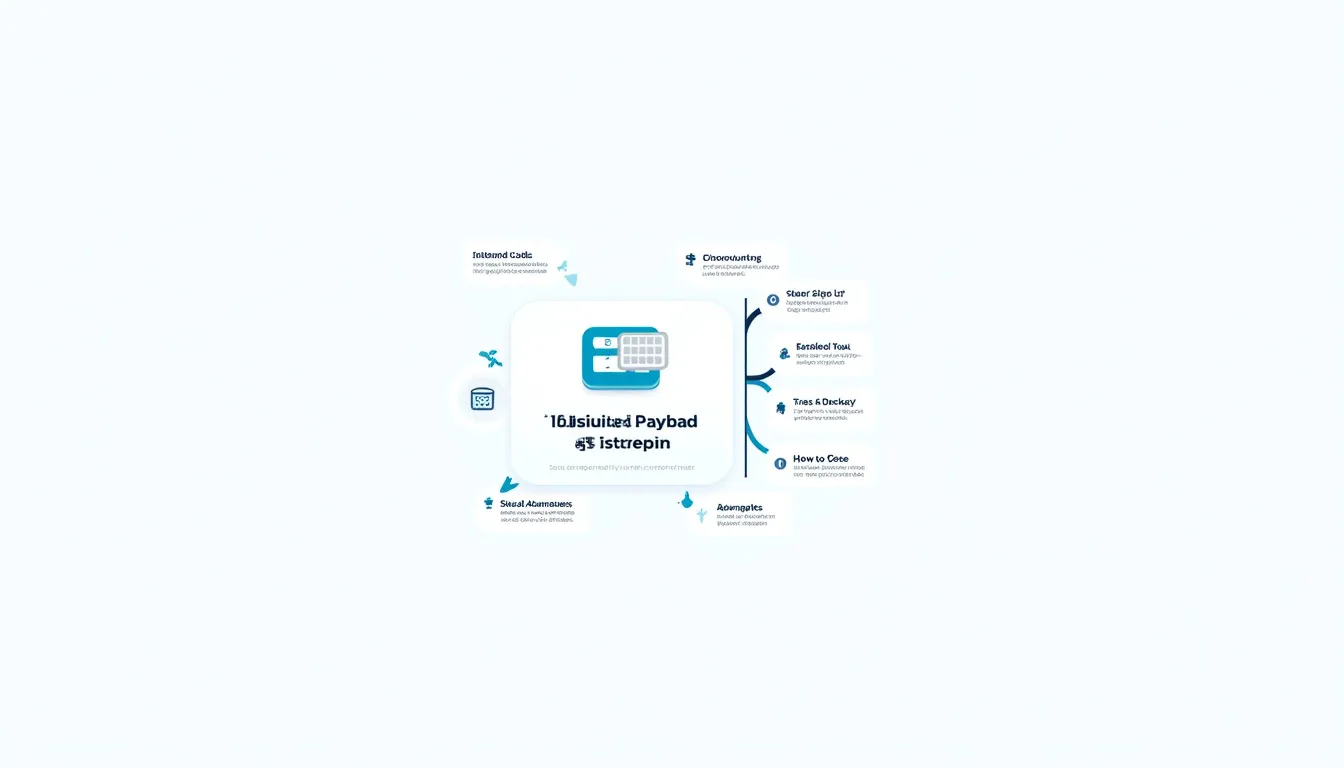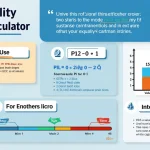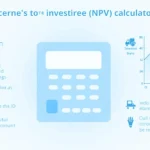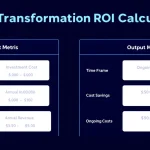Discounted Payback Period Calculator
Is this tool helpful?
How to Use the Discounted Payback Period Calculator Effectively
Our Discounted Payback Period Calculator is designed to help you evaluate how long it will take for your investment to recover its initial cost, while factoring in the time value of money. Follow these simple steps to enter your data and get accurate results:
- Enter the Initial Investment (Outflow): Input the full upfront cost of your investment in USD. For example, enter 750,000 or 1,200,000 as your initial outflow.
- Specify the Discount Rate: Provide the discount rate as a decimal to represent your required rate of return. Examples include 0.07 for 7% or 0.12 for 12%.
- Input the Periodic Cash Flow: Enter the expected periodic cash inflows generated by the investment in USD. Sample values could be 120,000 or 200,000 per period.
- Calculate: Click the “Calculate” button to view the discounted payback period, showing how many years it will approximately take to recover your initial investment considering the discounting effect.
- Interpret the Result: Use the displayed period in years to assess investment viability and compare projects effectively.
Understanding the Discounted Payback Period: Definition, Purpose, and Benefits
The Discounted Payback Period is a financial metric that refines traditional payback analysis by incorporating the time value of money. It estimates the time required to recover the initial investment after discounting future cash flows to their present value, enabling a more precise profitability and risk evaluation of any investment project.
Purpose of the Discounted Payback Period
- Evaluate the feasibility and profitability of an investment opportunity with consideration of the discount rate.
- Compare different investments by analyzing their risk and returns adjusted for time value.
- Assist in determining the time frame required to break even on the initial capital outlay.
- Integrate discounting for more realistic financial decision-making.
Key Benefits of Using the Discounted Payback Period Calculator
- Accounts for Time Value of Money: Recognizes that future cash inflows are worth less than current dollars.
- Enhanced Risk Assessment: Helps you understand the payback speed after discounting, providing insight into investment risk.
- Improved Investment Comparisons: Facilitates objective comparisons across projects with diverse cash flow timings.
- Supports Capital Budgeting: Assists businesses in allocating capital more effectively based on discounted recovery time.
- Accuracy Over Simple Payback: Offers a closer approximation of profitability timelines than non-discounted methods.
Example Calculation Using the Discounted Payback Period Calculator
Suppose you have the following investment details:
- Initial Investment (Outflow): $850,000
- Discount Rate: 0.09 (9%)
- Periodic Cash Flow: $150,000
Using the calculator, the discounted payback period (DPP) is computed as:
$$ DPP = \frac{\log\left(\frac{1}{1 – \frac{I \times r}{C}}\right)}{\log(1 + r)} $$
Where:
I = Initial Investment ($850,000)
r = Discount Rate (0.09)
C = Periodic Cash Flow ($150,000)
Plugging in the values gives a discounted payback period of approximately 6.08 years. This means your investment will likely recover its initial cost after about six years when considering discounted cash inflows.
How the Discounted Payback Period Calculator Meets Your Investment Analysis Needs
1. Simplifies Complex Financial Calculations
Manual computation of discounted payback can be tedious and error-prone. This calculator automates the formula, allowing you to quickly and accurately estimate investment recovery periods with ease.
2. Incorporates the Important Time Value of Money Factor
Unlike conventional payback calculations, this tool factors in discount rates, thereby improving the precision of payback timing and profitability estimations for your investments.
3. Enables Effective Investment Opportunity Comparison
By providing standardized discounted payback periods, you can readily compare different projects with varying cash flow structures and make well-informed capital allocation decisions.
4. Assesses Investment Risk via Payback Timing
Since shorter discounted payback periods generally signify less exposure, this calculator assists in balancing risk and returns during your evaluation process.
5. Facilitates Sound Capital Budgeting Decisions
Financial managers can leverage this tool to prioritize projects efficiently, ensuring available funds are directed towards investments that recover costs timely when considering discounted cash flows.
Practical Applications & Real-World Use Cases
Manufacturing Plant Machinery Upgrade
A factory invests $650,000 in new machinery, expecting $100,000 in annual savings. With a discount rate of 10%, the discounted payback period calculator estimates roughly 7.12 years to recover this investment, helping the management decide if the upgrade aligns with its strategic goals.
Renewable Energy Project Funding
An investment of $2,000,000 towards solar panels generates $300,000 per year, discounted at 7%. The calculator determines a payback period of about 8.18 years, providing a clear metric for sustainability-focused capital planning.
Small Business Marketing Campaign
A business spends $100,000 on a digital campaign with periodic revenue increments of $30,000 and a discount rate of 12%. The discounted payback period is approximately 4.47 years, allowing the team to evaluate campaign effectiveness and ROI realistically.
Technology Startup Investment
An angel investor contributes $500,000 expecting $120,000 annual returns discounted at 15%. The calculator shows an estimated discounted payback period of 5.35 years, supporting risk assessment and investment horizon decisions.
Frequently Asked Questions (FAQ) About the Discounted Payback Period
What’s the difference between the Simple Payback Period and Discounted Payback Period?
The Simple Payback Period ignores the time value of money, measuring only when initial investment is recovered. In contrast, the Discounted Payback Period accounts for discounting future cash flows, providing a more accurate timing of payback.
How does the discount rate impact the discounted payback period?
A higher discount rate increases the discounted payback period by reducing the present value of future cash flows, making payback appear later. Conversely, a lower rate shortens the period.
Are there any limitations to using the discounted payback period?
Yes, including:
- Excludes cash flows after the payback period, ignoring total project profitability.
- Can favor projects with quicker payback over those with superior long-term returns.
- Assumes constant periodic cash flows, which may not fit all investments.
How do I determine an appropriate discount rate?
Your discount rate should reflect your required rate of return or cost of capital and can be informed by metrics such as company weighted average cost of capital (WACC), risk-free rates plus premiums, or opportunity costs.
Can the discounted payback period ever be negative?
No, a negative result indicates the investment will not recover its initial cost under the provided parameters and cash flows, signaling a non-viable investment.
How does this metric compare to others like NPV or IRR?
The discounted payback period focuses on the timing of cost recovery, while Net Present Value (NPV) and Internal Rate of Return (IRR) assess overall profitability and return rates. It’s best to use these metrics in combination for well-rounded investment analysis.
Is a shorter discounted payback period always better?
Generally, a shorter period indicates quicker recovery and less risk, but it should not be the sole criterion. Some longer duration projects may offer higher overall returns or strategic advantages.
Can I use this calculator for investments with irregular cash flows?
This calculator assumes consistent periodic cash flows. For varying or irregular cash flows, consider more advanced financial models or tools that account for individual period cash inflows.
How accurate is the Discounted Payback Period Calculator?
While this tool is designed for accuracy, it depends on the correctness and realism of your input data. Always validate critical investment decisions with thorough analysis and consult financial experts when necessary.
Conclusion: Unlocking the Full Potential of the Discounted Payback Period Calculator
The Discounted Payback Period Calculator empowers investors, entrepreneurs, and finance professionals to make smarter, data-driven investment choices by factoring in the time value of money. Using this tool leads to:
- More precise assessment of investment recovery times.
- Improved risk management and capital allocation.
- Streamlined comparison across varied investment opportunities.
- Faster, automated calculation of complex financial metrics.
To maximize benefits:
- Input accurate, realistic values for investments, discount rates, and cash flows.
- Combine discounted payback analysis with other key financial indicators for comprehensive insights.
- Regularly revisit your calculations to reflect changing market or project conditions.
- Recognize the tool’s limitations and treat it as one part of a multi-faceted investment evaluation approach.
- Consult with financial advisors when tackling complex or high-stakes investment decisions.
Start utilizing this powerful calculator today to optimize your investment evaluations and guide your financial strategies toward greater success and profitability.
Important Disclaimer
The calculations, results, and content provided by our tools are not guaranteed to be accurate, complete, or reliable. Users are responsible for verifying and interpreting the results. Our content and tools may contain errors, biases, or inconsistencies. Do not enter personal data, sensitive information, or personally identifiable information in our web forms or tools. Such data entry violates our terms of service and may result in unauthorized disclosure to third parties. We reserve the right to save inputs and outputs from our tools for the purposes of error debugging, bias identification, and performance improvement. External companies providing AI models used in our tools may also save and process data in accordance with their own policies. By using our tools, you consent to this data collection and processing. We reserve the right to limit the usage of our tools based on current usability factors.







